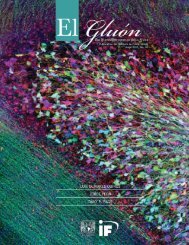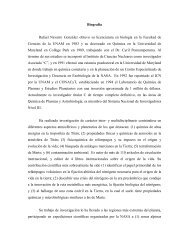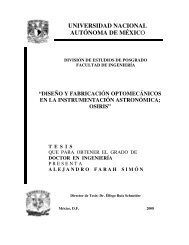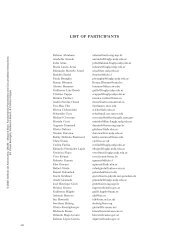Paola Marziani
Paola Marziani
Paola Marziani
Create successful ePaper yourself
Turn your PDF publications into a flip-book with our unique Google optimized e-Paper software.
<strong>Paola</strong> <strong>Marziani</strong><br />
Istituto Nazionale d’ Astrofisica, Osservatorio Astronomico di Padova, Italia<br />
Collaborators:<br />
Deborah Dultzin-Hacyan<br />
Jack W. Sulentic<br />
Radoslav K. Zamanov<br />
Giovanna M. Stirpe<br />
C. Alenka Negrete<br />
Massimo Calvani<br />
Rumen Bachev<br />
Sebastian Zamfir<br />
10”<br />
0.1”<br />
. The dot is the expected BLR size: ≈0.5 marcsec<br />
≈ 1/40 of the WFPC2 pixel size<br />
NGC 4388
D. P. Cox, conference summary at the Astrophysical Plasma conference, held in Mexico City<br />
in Nov. 1999:<br />
The average quasar spectrum from the SDSS (Van den Berk et al.)<br />
green bands: ranges where FeII emission is strong and can be easily measured<br />
The “one thousand” spectra are needed to exploit…
1) Spectral Variability (reverberation mapping)<br />
Optical/UV broad emission lines vary following continuum changes.<br />
An emissivity-weighted measure of the Broad Line Region linear<br />
distance r BLR from the continuum source is provided by the centroid of<br />
the cross correlation function between the continuum and any emission<br />
line light curve.<br />
r BLR from Hβ monitoring is available for 37 low-z AGN as of Dec.<br />
2006 (Kaspi et al. 2005, 2007)<br />
NGC 5548<br />
C(t) cont<br />
It turns out to be most useful to group emission lines depending on the ionization potential of their<br />
emitting ionic species:<br />
High ionization lines (HILs: ~40-50 eV): CIVλ1549, OIV]+SiIVλ1400 HeIIλ1640 HeIIλ4686<br />
Low ionization lines (LILs:
Pop. A<br />
Pop. B<br />
2) Spectral Diversity<br />
Narrow Line Seyfert 1s<br />
Sulentic, <strong>Marziani</strong>, & Dultzin-Hacyan 2000<br />
higher<br />
ionization<br />
prominent<br />
low ionization<br />
spectrum<br />
Emission line properties of quasars do not scatter randomly with reasonable dispersion around an<br />
average,<br />
Average spectra can be taken on bins in the ``Eigenvector 1 optical plane’’, or at least for Population A<br />
[FWHM(Hβ BC )≤4000 km s -1 ] and B(roader) sources . Narrow Line Seyfert 1s (NLSY1s) are in many<br />
ways undistinguished among Population A sources, as it will be shown in the next slides.
Continuum-subtracted spectra in the Hβ range<br />
from <strong>Marziani</strong> et al. 2003, ASpectral atlas of 215 low-z<br />
AGNs<br />
Diversity can be appreciated if<br />
spectral resolution and S/N<br />
are enough to:<br />
1. Deconvolve broad and<br />
narrow components;<br />
2. Measure broad profile<br />
parameters of relevant lines<br />
(e.g., Hβ BC , LIL, &<br />
CIVλ1549 BC , HIL);<br />
3. Subtract and measure<br />
intensity and FWHM of<br />
optical FeII lines, almost<br />
ubiquitous.<br />
These conditions are met by<br />
• the spectra for ~ 350 mainly low-z (
Continuum subtracted spectra in the Hβ range<br />
Hβ<br />
Within common S/N and λ/Δλ limits, at least optical FeII<br />
emission is self-similar in almost all sources, so that an<br />
intensity-scaled and broadened template provides an<br />
effective measurement and correction tool (Boroson &<br />
Green 1992; <strong>Marziani</strong> et al. 1996,2003). This has been<br />
known for almost 30 years (e.g., Phillips 1978).<br />
A more and more complex view is<br />
emerging as data improve…<br />
Appearance of the blue blend of FeII<br />
emission at λ4750, in simulated data<br />
with the S/N (>400) and dispersion<br />
expected for the VLT/FORS data.<br />
red lines: FeII and FeII] broad spectrum<br />
green line: narrow, low-ionization<br />
(mainly FeII and [FeII]) lines<br />
(cf.Veron-Cetty et al. 2004).<br />
.
10 15 ergs s -1 cm -2 Å -1<br />
10 15 ergs s -1 cm -2 Å -1<br />
Two representative sources with HST/optical data covering the ranges 1000-3000 Å and 4200-5500 Å<br />
Lyα CIV CIII+SiIII+<br />
AlIII<br />
Fairall 9 (Pop. B)<br />
Mkn 478 (Pop. A)<br />
MgIIλ2800 Hβ
10 15 ergs s -1 cm -2 Å -1<br />
10 15 ergs s -1 cm -2 Å -1<br />
Hß<br />
UV/optical spectrophotometric comparison<br />
of 2 proto-typical Pop. A (FWHM ≤ 4000 km/s) and B sources<br />
CIVλ1549<br />
NC<br />
FeII/FeIII<br />
model<br />
BC<br />
VBC<br />
blue comp.<br />
Fairall 9, Pop B<br />
Double Gaussian<br />
VBC redshifted<br />
Mkn 478, Pop. A<br />
Lorentzian<br />
blueshifted component<br />
very weak in Hβ
10 15 ergs s -1 cm -2 Å -1<br />
NC<br />
FeII/FeIII<br />
model<br />
BC<br />
VBC<br />
blue comp.<br />
MgIIλ2800<br />
(core fit only)<br />
Strongest UV lines can be consistently fit with the VBC/BC<br />
identified on Hβ and CIVλ1549<br />
CIII]λ1909<br />
Si III]λ1892<br />
Al IIIλ1860<br />
Deblending does not<br />
provide a unique<br />
solution…<br />
Fairall 9<br />
Mark 478<br />
CIIIλ1176<br />
Lyα<br />
NVλ1240
Cloudy simulations following Korista et. (1997), N H = 10 23 cm -2 , solar abundances<br />
Noticeable AlIIIλ1860 and CIII* λ1176 emission suggests high density and low ionization<br />
Ionization parameter Γ (=n γ /n e ) vs. electron density n e
Optical (normalized to Hβ) and UV (normalized to Lyα) Observed Emission Line Ratios<br />
Explorative Cloudy 7.0 photoionization computations incorporate Verner et al. (1999) 287-levels FeII,<br />
N H = 10 23 cm -2 , standard Laor et al. (1997) or Mathews & Ferland (1986) continuum, solar abundances<br />
deblend not<br />
unique for<br />
BC of F9 but<br />
consistent<br />
with<br />
SiIII]~CIII]<br />
and presence<br />
of<br />
Al III<br />
emission<br />
Pop. B → ←Pop. A<br />
LogΓ ~-2;<br />
ne ~<br />
10<br />
Redshifted<br />
Blueshifted<br />
:<br />
~0.15 ? ?<br />
Detected! <<br />
11-12<br />
cm-3 Log Γ ~ -<br />
0.5 ÷ -1.0;<br />
Some<br />
ne ~ 10<br />
caveats,<br />
but low<br />
ionization<br />
degree<br />
supported<br />
by FeUV<br />
and, if<br />
really<br />
present,<br />
CIII*<br />
9.5÷10<br />
cm-3 FeII UV →<br />
Log Γ≤ -2;<br />
High<br />
ne ≥ 10<br />
ionization,<br />
well<br />
accounted<br />
for.<br />
Canonical,<br />
may<br />
dominate<br />
Hβ<br />
emission in<br />
Pop. B.<br />
12<br />
cm-3 Log Γ ~<br />
-1 ÷-0.5;<br />
Very low<br />
ne ~<br />
10<br />
ion.,<br />
high<br />
density<br />
Gives the<br />
“low<br />
ionization<br />
look” to<br />
Pop. A<br />
sources.<br />
11 cm-3 High ion.,<br />
very weak<br />
in Balmer<br />
and other<br />
LILs<br />
VBC: high ionization, lower density. Well accounted for within a narrow range of Γ,n e<br />
BC: some puzzling aspects, but nothing really new: see Laor et al. (1997) findings for I Zw 1.
PG 1416-129<br />
It is the low ionization, broad component<br />
that seems (in some cases) to respond more<br />
strongly to continuum changes.<br />
The high-ionization VBC may be dominant<br />
in the sources with very weak FeII.<br />
Sulentic et al. 2000, 2006.
Pop. A<br />
Pop. B<br />
Narrow Line Seyfert 1s<br />
Statistical evidence confirms<br />
systematic trends in<br />
ionization and density along<br />
the sequence of spectral types.<br />
A3<br />
A2<br />
A1<br />
B1<br />
B1 +<br />
CIII]+Si III +AlIII<br />
(Bachev et al . 2004; no VBC+BC decomposition)
Pop. A<br />
Pop. B<br />
Narrow Line Seyfert 1s<br />
BLR Structural Difference between Population A and B<br />
sources (Sulentic et al. 2002, Bachev et al. 2004) is suggested by:<br />
Hβ BC<br />
Pop. A.: Lorentzian Hβ BC , symmetric (most often),<br />
or with blueward asymmetry<br />
Pop. B.: Double Gaussian Hβ BC , most often redward<br />
asymmetric<br />
CIVλ1549<br />
Median spectra<br />
Hβ BC<br />
CIV<br />
Pop. A.: Blueward asymmetric and blueshifted (most often),<br />
Pop. B.: Double Gaussian, redward asymmetric<br />
or symmetric<br />
Pop. A Pop. B
Pop B:<br />
FWHM(Civλ1549)<br />
and FWHM(Hβ BC )<br />
correlated,<br />
distribution not<br />
significantly<br />
different<br />
Pop A<br />
FWHM(Civλ1549)<br />
and FWHM(Hβ BC )<br />
and significantly<br />
different<br />
Civλ1549 blueshifts:<br />
likely for Pop. A<br />
Pop. A Civλ1549<br />
shift and FWHM<br />
correlated, Pop. B<br />
uncorrelated.<br />
Further statistical hints at structural differences in the BLR<br />
NLSy1<br />
Asymmetry index:<br />
Pop. A Civλ1549:<br />
Blueward asymmetric<br />
Pop. B Civλ1549:<br />
symmetric or slightly<br />
redward asymmetric,<br />
more like Hβ BC . Data from Bachev et al. 2004; Sulentic et al. 2007<br />
NLSy1<br />
(the centroid is defined<br />
with respect to rest frame)<br />
Pop. A<br />
Pop. B<br />
Civλ1549
NLSy1s don’t have peculiar BLRs.<br />
A first summary:<br />
Low-z quasars remain similar to NLSy1s up to FWHM(Hβ BC)≈4000 km s -1 .<br />
This limit seems better justified than 2000 km s -1 , since several observational<br />
properties change at 4000 km s -1 but not at 2000 km s -1 .<br />
Ionization is lower in Pop. A, and high ionization emission appears weak in the<br />
Balmer lines, and partially decoupled as well.<br />
CIV (HIL) and Hβ (LIL) are somewhat correlated in Pop. B. The high-ionization<br />
very broad emission may be dominant in Pop. B, even in the Balmer lines.<br />
Pop. A and Pop. B sources show different BLR ionization conditions and kinematics,<br />
but both may share a low-ionization region, and the difference may be due to a very<br />
broad component.<br />
Several of these findings were already discussed in the context of radio-loud and<br />
radio-quiet samples (Dultzin-Hacyan et al. 2000). An open question then and now is<br />
what is the physical reason for the BLR difference?
Composite spectra of RQ<br />
and RL (dashed)<br />
(after subtraction of the<br />
FeII opt template)<br />
Radio Loudness?<br />
RQ and RL objects in the mass interval 8.5 < log M<<br />
9.5 and any L/M ratio (N RQ = 56, N RL = 36; <strong>Marziani</strong> et<br />
al. 2003).<br />
The Hβ BC profiles of RQ and RL are almost identical.<br />
The BLR (but not the NLR) seems to be<br />
“transparent” to radio loudness .<br />
The few RL NLSy1 revealed until now do<br />
not look much different<br />
from RQ NLSy1s, although…<br />
Cleaned and<br />
scaled<br />
Hβ BC profile.
VLT/ISAAC data: resolution and<br />
S/N of NIR spectra similar to the<br />
optical data in the Hβ<br />
spectral range; 50 sources observed.<br />
Luminous Quasars at z>1:<br />
still the same BLR dichotomy:<br />
Pop. A and Pop. B “types”<br />
Does luminosity<br />
matter?<br />
Pop. A<br />
Pop. B
A very shallow trend is expected for the minimum FWHM(Hβ BC ):<br />
FWHM<br />
min<br />
Unremarkable dependence<br />
even on a Δm ~10 range<br />
for low ionization lines<br />
0.<br />
08M<br />
B 10 −<br />
∝ for a radiator at Eddington limit, if broadening of Hβ is due to gas<br />
virial motion, and r BLR ∝ L 0.7 (see Sulentic et al. 2004 for details)
Black hole mass and Eddington Ratio Estimate<br />
The correlation between r BLR and luminosity, r BLR ∝ L α with α≈ 0.5 – 0.65 for the optical<br />
continuum and Hβ (Kaspi et al. 2005; Vestergaard & Peterson 2006) can be used to infer the<br />
black hole mass if the gas motion is virial:<br />
M<br />
BH =<br />
f<br />
r<br />
BLR<br />
FWHM<br />
G<br />
Observed profiles suggest that the virial assumption is at least reasonable for Low<br />
Ionization Lines (HβBC or MgIIλ2800). Uncertainty in MBH is anyway large, a factor 2-3 at<br />
best(e.g.: Peterson & Wandel 2000; Krolik 2001; see also Sulentic et al. 2006; <strong>Marziani</strong> et al. 2006, and<br />
references therein)<br />
Assuming a bolometric correction … (e.g.,Shang et al. 2004) Lbol ≈10 Lopt … it is possible to compute the Eddington ratio (∝ L bol /M BH ) from a single-epoch<br />
observation.<br />
This techniques has been applied to samples with hundreds and even thousands of AGN; it makes<br />
sense in spite of the uncertainty since M BH spans 4 orders of magnitudes.<br />
(e.g., Mc Lure & Dunlop 2004; Sulentic et al. 2006; <strong>Marziani</strong> et al. 2003)<br />
2<br />
f factor depending on BLR<br />
geometry, ~1<br />
G, gravitational constant
Hß + [OIII]<br />
Solid: 7.3 ≤ log M ≤ 8.3<br />
Dashed: 8.3 < log M ≤ 9.3<br />
Eddington Ratio matters<br />
M BH gives a second-order effect, mainly on the line wings<br />
Hß Broad Component
Gravitational redshift?<br />
If gas motion remains virial down to the inner edge of the BLR,<br />
then there is a simple relationship between the centroid at 0<br />
intensity and the FWZI, or better<br />
FWZIcorr (Hβ)=FWZIcorr (Hβ) – 2c(0/4):<br />
.<br />
2<br />
M BH FWZIcorr<br />
= f<br />
r<br />
G<br />
2c 0 ⎛<br />
⎜<br />
⎝ 4<br />
⎞<br />
⎟ =Δzgrav ≈<br />
⎠<br />
3 GMBH 2 c 2 rBLR,min loosely correlated (P ~ 10 -3 )<br />
BLR, min<br />
Amplitude of redward<br />
asymmetry depends on M<br />
but gravitational redshift<br />
seems to be statistically<br />
inadequate.<br />
Maybe in a few sources<br />
gravitational redshift<br />
dominates the shift of the<br />
line centroids.<br />
(Kollatschny et al. 2004)<br />
Expected c(0/4) for gravitational<br />
and transverse redshift
Pop. A<br />
Pop. B<br />
Narrow Line Seyfert 1s<br />
L/M-dependent “Baldwin effect”,<br />
i.e., lower ionization in Pop. A<br />
The Eddington ratio affects strongly<br />
also high ionization lines like CIV<br />
Large blueshifys are confined<br />
to Population A sources
θ: angle between the line of<br />
sight and the jet axis<br />
θ is estimated equalling the observed<br />
X-ray flux at 1KeV<br />
to the flux expected from<br />
the synchrotron self-Compton<br />
Process.<br />
(following Ghisellini et al. 1993)<br />
Doppler factor,<br />
and Lorentz factor,<br />
from the apparent<br />
velocity if the source is superluminal.<br />
Orientation matters, affecting<br />
the FWHM(Hβ BC ) by a factor ≈ 2<br />
(Sulentic et al. 2003; see also Collin et al. 2006)<br />
(Hα)<br />
Orientation<br />
Method limited to superluminal sources
LIL VBC: accretion disk?<br />
Chen & Halpern 1989:<br />
R in =350 R g ,<br />
R out = 1000 R g ,<br />
i=32 o<br />
Major issues:<br />
Few (~ 2% in the SDSS), very broad sources<br />
(FWHM ~ 6 times the average FWHM)<br />
(Strateva et al. 2003, 2007).<br />
Old criticism based on line profile shape<br />
for the wide majority of AGN is still<br />
standing (Sulentic et al., 1990, 2000)<br />
Most double-peaked profiles require non-axisymmetric<br />
or warped disks.<br />
Energy budget problem: external “illumination”<br />
needed (e.g., Strateva et al. 2007, papers by S. Collin,<br />
A. Dumont et al.)<br />
Eddington ratios are much lower than those of<br />
typical type-1 AGN: < 0.02 in 90% of DP sources<br />
(Wu & Liu 2004): AD “bared”?<br />
Two component models for the LILs: disk (VBLR)<br />
+ spherical (Popovič et al. 2004): successful for 12<br />
AGNs, Pop. A and Pop. B.<br />
Wider sample, E1-organized is needed (in preparation…)
Concluding…<br />
Several BLR physical and kinematical properties seem to be mainly governed<br />
by Eddington ratio. It was not so clear 10 years ago.<br />
The BLR seems to be transparent to radio loudness. LIL properties are rather<br />
similar over a very wide range of luminosity, even at very high z.<br />
Observations until now constrain a semi-qualitative sketch of the BLR<br />
structure and dynamics. An accretion disk wind suits the high ionization<br />
findings for Pop. A.<br />
High-resolution spectra suggest that the LILs of a few Seyfert nuclei are<br />
emitted in a continuous flow… the accretion disk?<br />
How does the viewing angle affect observed BLR parameters?<br />
A thorough optical/UV spectrophotometric analysis that includes FeII requires<br />
great improvements in S/N and dispersion.<br />
UV data are not easy to come… WSO/UV for the future?










